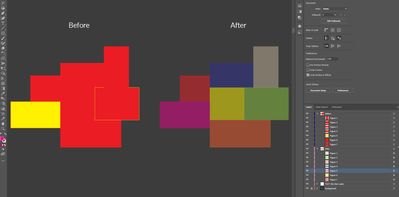Copy link to clipboard
Copied
I do have figures with propertyes:
Layer: RandomName
Number of figures: Random (sometimes 100+)
Corners: Random
Colour: Random
Stroke: Random
Endgoal:
Select all the figures, run the script and each figure to get an unique color (not slightly changed - that is not visible for the eye). Each figure to have only "fill" without "stroke" and opacity set to 50%.*
*In the example picture they are two layers for representing purpouses only. It needs to change the settings in the current layers the figures are located.
 1 Correct answer
1 Correct answer
This is my immediate simple thought. There are 16 million RGB colors, so it's improbable that you'll get the same color twice. But there are only 18 primary, secondary, and tertiary colors, so it's probable that you'll get colors close to each other.
// select paths
for (var i = 0; i < app.selection.length; i++) {
var colour1 = new RGBColor();
colour1.red = randomise();
colour1.green = randomise();
colour1.blue = randomise();
app.selection[i].stroked = false;
app.selecExplore related tutorials & articles
Copy link to clipboard
Copied
Hi @D.S.., this is how I would approach this challenge. I'd collect the swatches in the document, shuffle them, and apply them to each item. So this way, you would set up your acceptable colors as swatches first. Maybe this doesn't suit your case? Anyway have a look at this script.
There are 2 example usages of the function to show you the possibilities.
- Mark
/*
Apply Random Swatches to Items
by m1b
here: https://community.adobe.com/t5/illustrator-discussions/can-someone-share-script-that-changes-the-color-of-random-number-of-figures/m-p/12888650
*/
var doc = app.activeDocument;
// example usage 1: all page items, all swatches
applyRandomSwatchesToItems(doc.pageItems, getDocumentColors(doc));
// example usage 2: selected items only, swatches in 'Brights' swatch group only
// applyRandomSwatchesToItems(doc.selection, doc.swatchGroups.getByName('Brights').getAllSwatches());
function applyRandomSwatchesToItems(items, colors) {
// make colors array at least as long as items array
while (items.length > colors.length)
colors.concat(colors.slice());
// randomise order of colors
colors = shuffleArray(colors);
// set item colors
for (var i = 0; i < items.length; i++)
setItemColor(items[i], colors[i], 'fill');
}
function getDocumentColors(doc, includeGradients, includePatterns) {
var swatches = doc.swatches;
// make array of colors
var colors = [];
for (var i = 0; i < swatches.length; i++) {
var sw = swatches[i];
// skip unwanted swatches
if (
sw.color.typename == 'NoColor'
|| (
sw.color.typename == 'SpotColor'
&& sw.color.spot.colorType == ColorModel.REGISTRATION
)
|| (sw.color.typename == 'GradientColor' && includeGradients != true)
|| (sw.color.typename == 'PatternColor' && includePatterns != true)
)
continue;
// add swatch color to array
colors.push(sw.color);
}
return colors;
}
function shuffleArray(arr) {
var i = arr.length,
j = 0,
temp;
while (i--) {
j = Math.floor(Math.random() * (i + 1));
temp = arr[i];
arr[i] = arr[j];
arr[j] = temp;
}
return arr.slice();
};
function setItemColor(item, swatch, fillOrStroke) {
if (item == undefined) throw 'setItemColor: No item supplied.';
var _color,
fillOrStroke = fillOrStroke || 'fill',
fillOrStrokeColor = fillOrStroke == 'stroke' ? 'strokeColor' : 'fillColor',
filledOrStroked = fillOrStroke == 'stroke' ? 'stroked' : 'filled';
if (swatch.typename == 'Swatch')
_color = swatch.color;
else
_color = swatch;
try {
switch (item.typename) {
case "PathItem":
item[filledOrStroked] = true;
item[fillOrStrokeColor] = _color;
break;
case "CompoundPathItem":
if (item.pathItems)
item.pathItems[0][filledOrStroked] = true;
item.pathItems[0][fillOrStrokeColor] = _color;
break;
case "TextFrame":
var trs = item.textRanges;
for (var i = 0; i < trs.length; i++)
trs[i][fillOrStrokeColor] = _color;
break;
default:
// a different type of item
break;
}
} catch (error) { }
}
Copy link to clipboard
Copied
This is my immediate simple thought. There are 16 million RGB colors, so it's improbable that you'll get the same color twice. But there are only 18 primary, secondary, and tertiary colors, so it's probable that you'll get colors close to each other.
// select paths
for (var i = 0; i < app.selection.length; i++) {
var colour1 = new RGBColor();
colour1.red = randomise();
colour1.green = randomise();
colour1.blue = randomise();
app.selection[i].stroked = false;
app.selection[i].filled = true;
app.selection[i].fillColor = colour1;
app.selection[i].opacity = 50;
}
function randomise() {
return Math.floor(Math.random() * 256);
}
Copy link to clipboard
Copied
It does the job perfecrly! Thank you again. 🙂


